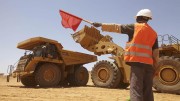First the good news: Quebec’s decision last week to add mining to the list of priority activities and services permitted during the pandemic elicited quiet cheers from investors and lifted the spirits of gold miners like Agnico Eagle, Yamana, Iamgold, Hecla and Eldorado, which said they would cautiously re-open their mines under strict health and safety protocols. (At last count, Quebec has more than half of Canada’s COVID-19 cases and about 47% of its recorded deaths.)
There was room for some optimism in Europe, too, as Germany – a leader among Western nations in combating the virus – said it would begin easing some restrictions on movement and allow a handful of businesses to re-open, including bookstores, bike shops and car dealers. Chancellor Angela Merkel – who trained in science — has shown the world what early and widespread testing, sufficient numbers of beds in intensive care units, and well-observed social distancing policies can achieve, and the country has already begun testing people for immunity to the virus.
Other signs of hope came from Oxford University, where test trials of a coronavirus vaccine on humans have begun and could be completed as early as mid-August, according to The Guardian newspaper.
Meanwhile in the United States, the Dow Jones Industrial Average “staged its best two-week performance since the 1930s,” The Wall Street Journal reported on April 17, noting that the “explosive rally is a sign that many are positioning for the U.S. to make a speedy recovery when the coronavirus crisis eases.” (The paper also pointed out, however, that the stock market rally – driven mainly by massive stimulus measures from the U.S. government and Federal Reserve – underscored “a confounding reality: soaring share prices and a floundering economy.”)
Now for the bad headlines: For the first time in history, U.S. crude oil futures fell below US$0 on Monday “amid a coronavirus-induced supply glut, ending the day at a stunning minus US$37.63 per barrel as desperate traders paid to get rid of oil,” our sister publication, The Daily Oil Bulletin, reported on April 20. “The May U.S. WTI contract fell US$55.90, or 306%, to settle at a discount of US$37.63 per barrel, after touching an all-time low of -US$40.32 per barrel. Brent was down $2.51, or 9%, to settle at US$25.57 per barrel.”
In other news, the International Monetary Fund warned last week that it expects the world economy will contract by 3% in 2020, as the virus continues to lock-down nations. “It is very likely that this year the global economy will experience its worst recession since the Great Depression, surpassing that seen during the global financial crisis a decade ago,” Gita Gopinath, the IMF’s chief economist, told reporters last week.
While economists ponder whether the recovery will be V-shaped or U-shaped or look more like a W, the stats published last week offered little guidance and even less comfort. Twenty-two million people in the U.S. have filed for unemployment benefits in the last month, “the largest and most dramatic rise in claims on record since the Labor Department started tracking the data in 1967,” according to CNN; and a recent survey of 57 economists by The Wall Street Journal concluded that the unemployment rate in the U.S. will hit a record 13% in June.
China reported the first contraction in quarterly GDP (6.8%) since the country began releasing the numbers in 1992. “The nature of the shock is really different than anything we’ve ever seen in our lifetimes,” Goldman Sach’s chief Asia Pacific economist Andrew Tilton told The WSJ. While a fragile recovery there is now underway, China’s exports to Europe and the U.S., two of the country’s largest partners in trade, fell by more than 20% year-on-year in March, while domestic retail sales were down 16% compared with the same month in 2019.
Then there was the absurd: Not only did U.S. President Donald Trump threaten to cut off funding to the World Health Organization but he also supported anti-government protestors in some states that want an end to stay-at-home orders. In tweets Trump wrote: “LIBERATE MICHIGAN!” and “LIBERATE MINNESOTA!” – a day after announcing guidelines for governors to re-open the economy and saying that the decision to relax restrictions rested with state governors.
Ultimately, the timing of when to start easing restrictions must boil down to the extent to which adequate testing and contact-tracing measures are in place. And that time still seems quite a long way off. According to The New York Times, citing the CCOVID Tracking Project, about 150,000 diagnostic tests are being done a day in the U.S., but “new estimates by researchers at Harvard University suggest that the United States cannot safely reopen unless it conducts more than three times the number of coronavirus tests it is currently administering over the next month.”





Be the first to comment on "Editorial: The good, the bad and the absurd"